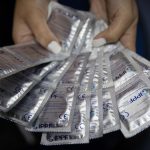Approximately 30% of human tumors carry mutations in some component of the RAS-ERK biochemical pathway. This route is made up of four proteins: RAS, RAF, MEK and ERK, which activate one another, sequentially and successively, coupling a transmission chain through which the necessary mechanisms for cell proliferation are put into operation. In tumor cells, mutations in any of these proteins cause said transmission chain to be aberrantly activated, constantly, so that the cells proliferate uncontrollably.
The importance of this pathway in carcinogenesis is such that, in the last 25 years, large pharmaceutical companies have invested billions of dollars in designing compounds through which uncontrolled signaling through it can be stopped. As a result of this effort, today the components of this pathway constitute promising molecular targets towards which several antitumor drugs are directed, successfully used in the clinical setting for the treatment of tumors such as lung cancer, colorectal cancer and melanoma. .
The transmission of signals through the RAS-ERK pathway is optimized through the participation of “framework proteins”, in charge of assembling the four components properly. A few decades ago it was discovered that mice deficient in one of these proteins, called KSR, were extremely resistant to developing tumors, raising the hypothesis that inhibiting KSR activity could be a valid strategy as antitumor therapy. In this sense, in 2015 a molecule, APS 2-79, was presented that blocked the activity of KSR at the level of its interaction with MEK. However, its antitumor effect was very disappointing, so its clinical development was not continued.
In new research, the reason for the failure has been discovered.
The study is the work of an international team that includes Piero Crespo and Berta Casar, both from the Cancer Network Biomedical Research Center (CIBERONC) and the Institute of Biomedicine and Biotechnology of Cantabria (IBBTEC), as well as Xosé Bustelo from CIBERONC and the Cancer Research Center (CIC) attached to the Higher Council for Scientific Research (CSIC), in Spain all these entities. Specialists from the University of Edinburgh (United Kingdom) and the National Institutes of Health (NIH) in the United States have also participated.
Image of the components of a tumor. (Photo: IBBTEC)
The reason for the failure of APS 2-79 is that several types of scaffold proteins exist in cells, and in tumor cells, one of these, called IQGAP1, binds to KSR. Due to this interaction, MEK bound to IQGAP1 can activate ERK bound to KSR. IQGAP1 thus serves as a molecular bridge through which the inhibitory effect of APS 2-79 is avoided. Thus, IQGAP1 would act as a splice, restoring the flow of signals through the KSR, according to the researchers. Based on the finding, the authors of the study have shown that in melanoma cells devoid of IQGAP1, the antitumor effect of APS 2-79 is greatly increased.
KSR remains a very promising therapeutic target. The reason for the failure of APS 2-79 is that its mechanism of action is not adequate. To effectively block the activity of KSR, its interaction with ERK must be prevented, only then will molecular splicing processes such as those described be avoided”, the researchers argue. In this sense, Crespo and Casar are already looking for such types of inhibitors. (Source: IBBTEC / CSIC)










![[Img #67997]](https://thelatestnews.world/wp-content/uploads/2023/02/They-discover-why-certain-antitumor-compounds-fail.jpg)


![[Img #73262]](https://thelatestnews.world/wp-content/uploads/2024/07/The-era-of-artificial-intelligence-in-digital-marketing-in-Spain-300x200.jpg)